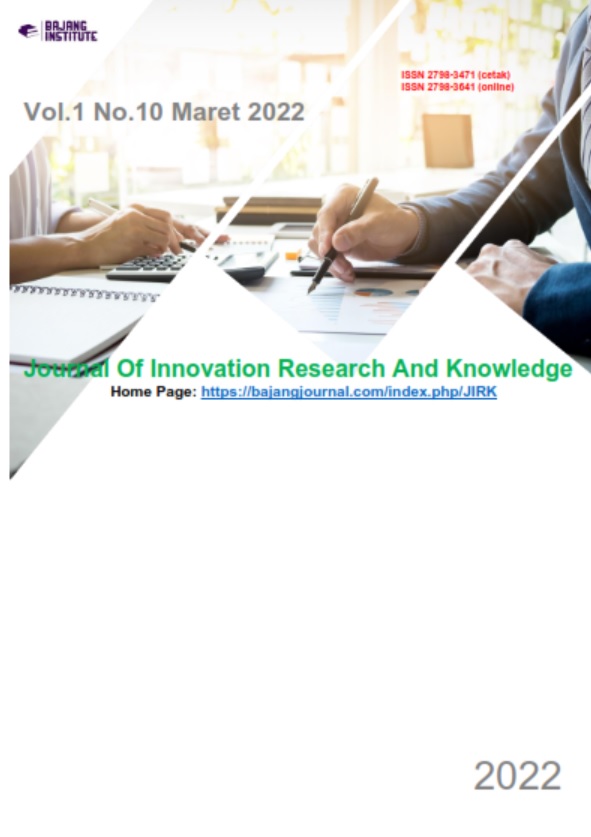PENGARUH TELENURSING PADA PENINGKATAN KUALITAS HIDUP PASIEN STROKE
DOI:
https://doi.org/10.53625/jirk.v1i10.1717Keywords:
Telenursing, Kualitas Hidup, StrokeAbstract
Stroke dapat mempengaruhi kehidupan pasien dalam berbagai aspek antara lain fisik, emosional, psikologis, kognitif, dan sosial. Tingkat kecacatan fisik dan mental pada pasien pasca stroke dapat mempengaruhi kulitas hidup pasien. Salah satu cara edukasi yang digunakan oleh perawat adalah dengan telenursing, karena dapat diakses dan diaplikasikan secara mudah, efektif dan efisien dalam memberikan edukasi kepada pasien maupun keluarga pasien stroke untuk meningktakan kualitas hidup pasien stroke. Tujuan: penelitian ini bertujuan untuk melihat pengaruh telenursing pada peningkatan kualitas kualitas hidup pasien stroke. Metode: Desain penelitian ini adalah literature review dengan boolean operator. Database yang digunakan adalah ProQuest, Ebscohost, Google Scholar, dan ScienceDirect. Hasil: Dari ketujuh jurnal didapatkan bahwa telenursing memberikan kemudahan dalam memberikan edukasi dan pelayanan kesehatan. Pasien maupun petugas kesehatan sama-sama menerima dan memberi pelayanan yang efisien dan efektif sehingga dapat meningkatkan kualitas hidup pasien stroke. Kesimpulan: Telenursing memberikan manfaat atau pengaruh yang baik bagi pelayanan keperawatan untuk meningkatkan kualitas hidup pasien stroke. Rekomendasi: Perlu dilakukan edukasi kepada pasien dan keluarga pasien stroke untuk lebih meningkatkan kualitas hidup pasien stroke.
References
American Heart Association. (2015). Heart disease and stroke-2014 update: A report from American Heart Association. Circulation.
Afik, A., & Glorino Rumambo Pandin, M. (2021). Telenursing as a New Nursing Paradigm in the 21 Century: A Literature Review [Preprint]. MEDICINE & PHARMACOLOGY. https://doi.org/10.20944/preprints202103.0704.v1
Bariroh U., (2016). Faktor-faktor yang Berhubungan dengan Kualitas Hidup Pasien Pasca Stroke (Studi di RSUD Tugurejo Kota Semarang)
Blake H. (2008). Mobile Phone Technology in Chronic Disease Management. Nursing Standar.23,12,43-46. http://media.proquest.com/. pada tanggal 02 Februari
Canadian Nurses Assosiation. 2005.
Carod-artal, F.J. &Egido, J. A. (2014). Quality of life after stroke: The Importance of a Good Recovery
Farida I, & Amalia. (2009). Mengantisipasi stroke. Yogyakarta: Bukubiru.
Fransisca, B. (2011). Asuhan Keperawatan pada Klien Gangguan Sistem Peryarafan, Jakarta: Salemba Medika.
Hamid Taghinejad. 2018. Investigating the effects of nurse post-discharge follow-up phone calls on the self-efficacy of patients caregivers suffering from stroke. Bali Medical Journal.
Jerry C K Lai. 2004. Telerehabilitation — a new model for community-based stroke rehabilitation. Journal of Telemedicine and Telecare
Kurnia, E. 2020. Kualitas Hidup pada pasien pasca Stroke. Jurnal Penelitian Keperawatan. Volume 6. No.2. Kediri: Stikes RS Baptis.
Lee RG, Chen KC, Hsiao CC, Tseng CL. 2007. Mobile care system with an alert mechanism. IEEE Trans Inf Technical Biomol.; 11 : 507-517.
Li-Chi Chiang, 2012. The effect of sustained nursing consulting via telephone (Tele Nursing) on the quality of life in hypertensive patients. Applied Nursing Research.
Li-Chi Chiang et al, 2012. The effectiveness of telehealth care on caregiver burden, mastery of stress, and family function among family caregivers of heart failure patients: A quasi-experimental study. International Journal of Nursing Studies.
Lili, I& Catur. (2016), Care Your Self, Stroke, Jakarta: Penebar Plus.
Maryam Goudarzian, 2018. Effect of Telenursing on Levels of Depression and Anxiety in Caregivers of Patients with Stroke: A Randomized Clinical Trial. Iranian Journal of Nursing and Midwifery Research.
Ngatini, dkk. 2016. Pengaruh Latihan Pasarah Diri dan Latihan Range of Motion melalui Discharge Planing terhadap Perubahan Activity daily Living pada pasien Stroke Iskemik. Indonesian Journal of Nursing Practice. Vol 1 No 1. Desember 2016.
Nurse One, the Canadian Nurses Portal Ottawa. Diperoleh melalui www.cna-alic.ca pada tanggal 30 April 2015.
Potter, P. A., & Perry, A. G. (2005). Buku Ajar fundamental keperawatan: Konsep, Proses, dan Praktek. Jakarta: EGC.
World Health Organization (WHO). (2018). Stroke, Cerebrovascular Accident. Diambil dari http://www.who.int/topics/cerebrovascular_accident/en/
Palmira Bernocchi. 2015. Home-based telesurveillance and rehabilitation after stroke: a real-life study. Topics in Stroke Rehabilitation
Riskesdas dalam Angka, 2018.
Somayeh Kazem, 2016. Comparing the effects of two methods of self-monitoring and telenursing on the blood pressure of patients with hypertension. International Journal of Medical Research & Health Sciences
Scotia. (2008). Telenursing Practice Guideline. College of Registered Nurses of Nova Scotia. www.proquest.com. Diakses pada tanggal 27 Mei 2015.
Suhud, M. (2009). Cuci Darah Demi Kualitas Hidup. Kompas Syb













